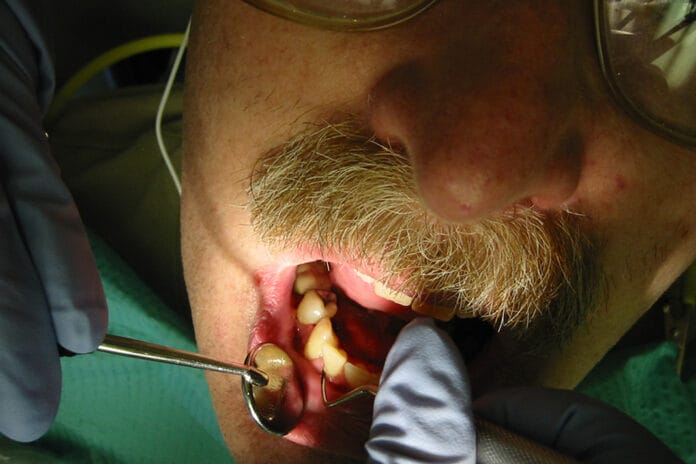As a hobby, I enjoy reading scientific literature published in the 1800s and a few from the early 1900s. What fascinates me is just how far we have come in medicine and dentistry. The progress we have made ‒ not only making treatment more comfortable for patients but also the updated evidence-based protocols for clinicians that provide the guidance for proper care and support a healthy dentition ‒ is simply mindboggling.
In one case study I read from 1893, the authors stated, “Disease of the antrum, resulting from dental troubles, are by no means infrequent, and are often of a very grave character.” This entire case study was essentially about an abscessed tooth that perforated the sinus and, as you can imagine, was causing this patient a great deal of pain. The authors describe the patient’s eye as being so swollen that it was “most wholly out of the socket.” The recommended treatment included extracting the affected tooth, syringing out the socket through the nose, cleansing the socket with hydrogen peroxide for several days, and then following up with a “50 percent solution of campho-pheique in alcohol.”1
Can you imagine working in dentistry before anesthetics and antibiotics? For reference, lidocaine was developed in 1943 and marketed in 1948; prior to that, dentists often used options such as cocaine and whiskey to dull the pain of extractions.2 Penicillin was “officially” discovered on September 3, 1928. I say “officially” because there are some records of mold being used as an antimicrobial from ancient times.3
Enough about history; where are we today?
Scaling and Root Planing is History
In my opinion, the reason we still use the term “scaling and root planing” is because SRP is so easy to write and speak. However, we should not be root planing. The idea of “glassy smooth” root surfaces was abandoned many years ago.
Originally, scaling and root planing included gingival curettage. It was believed that removing the soft tissue of the inner surface of the periodontal pocket would promote new attachment. In the 1980s, this was challenged and determined not to be more beneficial than strictly scaling and root planning.4
Root planing was believed to be necessary for the removal of endotoxins impregnated into contaminated root surfaces. This was challenged in a clinical study published in 1995.5 This study showed similar improvements in patients who received root planing compared to those who only had biofilm and calculus deposits removed. This study showed the goal should be the removal and control of gram-negative anaerobic bacteria in the subgingival plaque biofilm and not the removal of “contaminated root cementum” via root planing.4,5
The current terminology is non-surgical periodontal therapy. I know that is a mouthful, but it’s important that we convey the treatment we plan to complete. I propose we abbreviate it NSPT and replace the outdated SRP.
The reason I want to encourage hygienists to update their verbiage is that patients have access to information at their fingertips. Imagine your patient looking up “scaling and root planing” and discovering it is an outdated treatment. That could potentially erode trust. In my opinion, trust is already an issue in dentistry. Taking measures to prevent further erosion of the little trust we have from the public may go a long way in advancing dental hygiene.
Non-surgical periodontal therapy no longer embraces the removal of tooth structure and/or soft tissue but rather the management of plaque biofilm to reduce inflammation and manage the disease process. This includes host modulation as well. Evidence shows that non-surgical periodontal therapy in patients with systemic disease that affects the immune response shows improvement in systemic health after treatment.6-9 Moving forward, let’s explain what we are doing and use correct terminology, which will likely help patients better understand and value the treatment we provide.
So Long, Irrigation
“Does your office charge for irrigation, and what do you use to irrigate?” I see this question in dental hygiene social media groups at least weekly ‒ sometimes daily. The correct answer is that you charge nothing because this is not an evidence-based procedure; therefore, you shouldn’t be offering it.
The scientific literature does not support subgingival irrigation. A randomized controlled trial evaluated the efficacy of subgingival irrigation during non-surgical periodontal therapy. The study compared sodium chloride 0.9% (saline as the control), chlorhexidine digluconate, and povidone-iodine on changes in probing depths, clinical attachment loss, and bleeding on probing. I should mention the follow-up in this trial is 12 months rather than the standard three to six months, which provides superior evidence.10
The results indicate no significant difference between the three. Though all subjects improved, it didn’t matter which subgingival irrigant was used; the improvements were statistically similar across the board. This indicates that non-surgical periodontal therapy is effective, adjunct irrigation is not necessary, and it is certainly not an evidence-based practice.10
This is certainly not the only randomized controlled trial with the same conclusion, but it is one of the most recent and the one with the longest follow-up. Even the Queen of dental hygiene, Esther Wilkins, states in the 10th edition back in 2009 of her textbook Clinical Practice of the Dental Hygienist that research shows that irrigating with chlorhexidine (CHX) shows no significant difference in outcomes (beyond instrumentation).11 If you are still irrigating, it’s time to put that irrigation syringe down. Save your time and the patient’s money because there is no evidence that it is beneficial.
See You Never, Full Mouth Debridement
Full mouth debridement is another hot topic that needs to be retired almost completely. A true full mouth debridement is meant to remove deposits “to enable a comprehensive periodontal evaluation and diagnosis on a subsequent visit.”12 The need for this procedure arises when periodontal probing and proper access and assessment of tooth surfaces are not possible because of excessive plaque and calculus.
The likelihood that you will have a patient who needs a true full mouth debridement is very low, apart from those working in public health, where they may be more common. However, I have had two in my career that qualify as true full mouth debridement. I’ve generally worked in private practice, and this is over a 20-year span.
Many hygienists inquire about doing a full mouth debridement prior to non-surgical periodontal therapy or as a “difficult prophy.” However, the idea of doing this “was abandoned years ago.”11
Moreover, recent studies indicate full mouth non-surgical periodontal therapy is more beneficial than quadrant treatments. This was investigated in the 1990s, and the research indicates that “scaling to completion” is the best approach.11 This can be difficult to achieve due to time constraints, hand fatigue, and insurance coverage.
Accordingly, the protocol recommends completing treatment within 24 hours, allowing for split mouth non-surgical periodontal therapy.13 Essentially, the idea is to achieve full mouth disinfection through non-surgical periodontal therapy as quickly as possible and in as few visits as possible. Adding a third appointment to accommodate full mouth debridement is not recommended, nor is it beneficial to the patient’s oral health and lifestyle regarding time and money.
Conclusion
Keeping up with evidence-based approaches to clinical dental care can be time-consuming and overwhelming. However, it is our duty as clinicians to stay up to date on the latest research and be willing to change our practices based on new emerging evidence. Just as I’m sure you cannot imagine practicing dentistry in the 1800s, someday, dental hygienists will look back on root planing, irrigation, and full mouth debridement with utter disgust and concern for our patients. We always do what is best until we know better. Now you know better.
Before you leave, check out the Today’s RDH self-study CE courses. All courses are peer-reviewed and non-sponsored to focus solely on high-quality education. Click here now.
Listen to the Today’s RDH Dental Hygiene Podcast Below:
References
- Rominger, C.A. A Brunswick Stew. The American Journal of Dental Science. 1893; 27(7): 325-329. https://www.ncbi.nlm.nih.gov/pmc/articles/PMC6114683/
- Cervino, G. Milestones of Dentistry: Advent of Anesthetics in Oral Surgery. Dentistry Journal. 2019; 7(4): 112. https://www.ncbi.nlm.nih.gov/pmc/articles/PMC6960780/
- Aminov, R.I. A Brief History of the Antibiotic Era: Lessons Learned and Challenges for the Future. Frontiers in Microbiology. 2010; 1: 134. https://www.ncbi.nlm.nih.gov/pmc/articles/PMC3109405/
- Heitz-Mayfield, L.J., Lang, N.P. Surgical and Non-Surgical Periodontal Therapy. Learned and Unlearned Concepts. Periodontology 2000. 2013; 62(1): 218-231. https://pubmed.ncbi.nlm.nih.gov/23574468/
- Mombelli, A., Nyman, S., Brägger, U., et al. Clinical and Microbiological Changes Associated with an Altered Subgingival Environment Induced by Periodontal Pocket Reduction. Journal of Clinical Periodontology. 1995; 22(10): 780-787. https://pubmed.ncbi.nlm.nih.gov/8682925/
- Escobar Arregocés, F.M., Del Hierro Rada, M., Sáenz Martinez, M.J., et al. Systemic Inflammatory Response to Non-Surgical Treatment in Hypertensive Patients with Periodontal Infection. Medicine. 2021; 100(13): e24951. https://www.ncbi.nlm.nih.gov/pmc/articles/PMC8021383/
- Yun, F., Firkova, E.I., Jun-Qi, L., Xun, H. Effect of Non-Surgical Periodontal Therapy on Patients with Type 2 Diabetes Mellitus. Folia Medica. 2007; 49(1-2): 32-36. https://pubmed.ncbi.nlm.nih.gov/18018467/
- Bokhari, S.A., Khan, A.A., Butt, A.K., et al. Non-Surgical Periodontal Therapy Reduces Coronary Heart Disease Risk Markers: A Randomized Controlled Trial. Journal of Clinical Periodontology. 2012; 39(11): 1065-1074. https://pubmed.ncbi.nlm.nih.gov/22966824/
- Sun, J., Zheng, Y., Bian, X., et al. Non-Surgical Periodontal Treatment Improves Rheumatoid Arthritis Disease Activity: A Meta-Analysis. Clinical Oral Investigations. 2021; 25(8): 4975-4985. https://pubmed.ncbi.nlm.nih.gov/33515120/
- Krück, C., Eick, S., Knöfler, G.U., et al. Clinical and Microbiologic Results 12 Months after Scaling and Root Planing with Different Irrigation Solutions in Patients with Moderate Chronic Periodontitis: A Pilot Randomized Trial. Journal of Periodontology. 2012; 83(3): 312-320. https://pubmed.ncbi.nlm.nih.gov/21749169/
- Matsuda, S. A. (2009). Non-Surgical Periodontal Instrumentation. In E. M. Wilkins, Clinical Practice of the Dental Hygienist (10th ed., pp. 641-673). Lippincott Williams & Wilkins.
- D4355 – ADA Guide to Reporting Full Mouth Debridement [Version 2]. (2023, January). American Dental Association. https://www.ada.org/-/media/project/ada-organization/ada/ada-org/files/publications/cdt/v2_d4355adaguidetoreportingfullmouthdebridement_2023jan.pdf
- Tomasi, C., Wennström, J.L. Full-Mouth Treatment vs. the Conventional Staged Approach for Periodontal Infection Control. Periodontology 2000. 2009; 51: 45-62. https://pubmed.ncbi.nlm.nih.gov/19878469/












